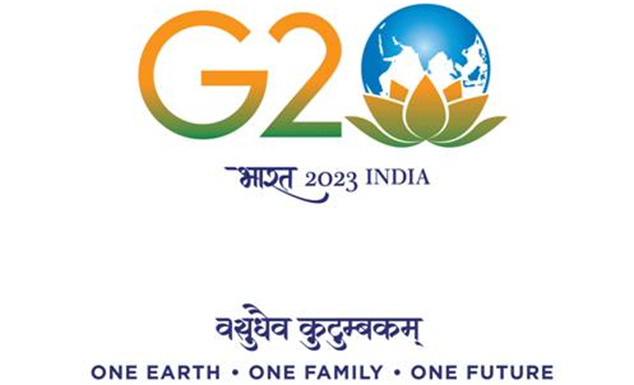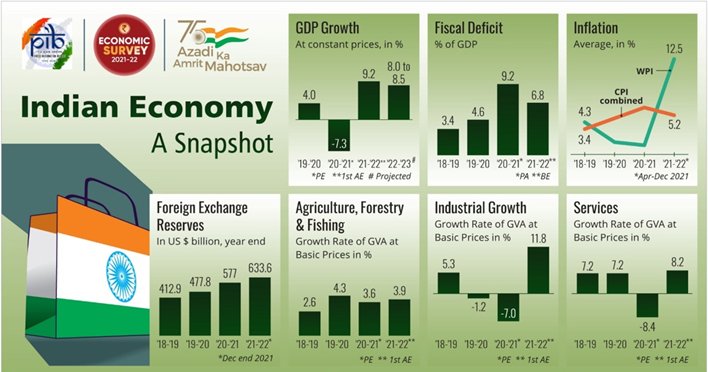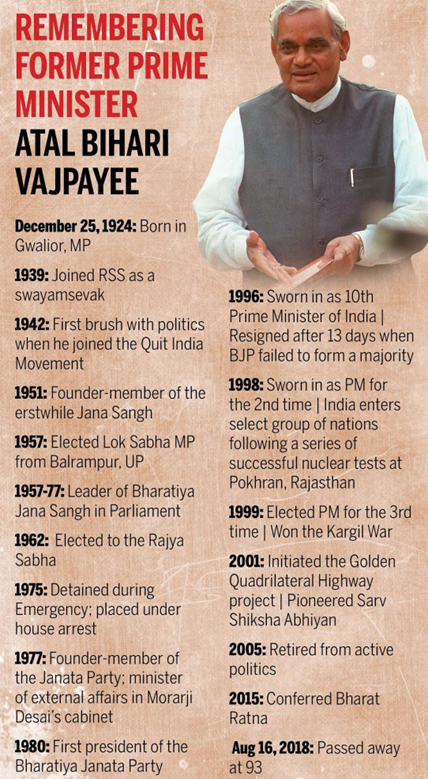Friday, 30th December 2022
2022: ‘the year of unprecedented hunger’
In News
United Nations World Food Programme (WFP) called 2022 ‘the year of unprecedented hunger’ because of declining food security and increased hunger in several corners of the world this year. Systemic policy changes and global concerted efforts are necessary to alleviate the condition of these people and meet the UN-mandated Sustainable Development Goal of ‘Zero Hunger’ by 2030.
Global food systems
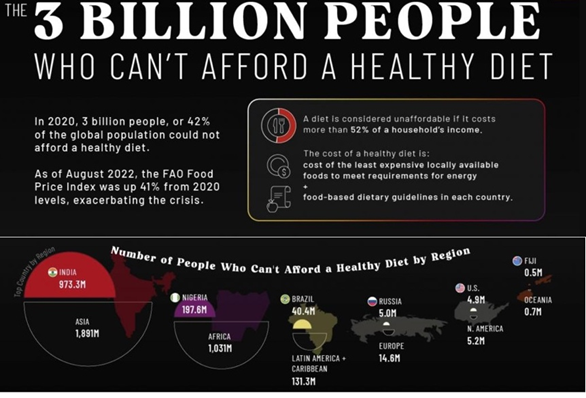
Requirement of wider systemic change to feed the population of the world:
- The report, titled ‘The Future of Food and Agriculture: Drivers and triggers for transformation’, analyzed current and emerging drivers of agrifood systems and their possible future trends.
- The document said the world was “tremendously off track” to meet the sustainable development goals (SDG), including agrifood targets.
70% of Indians cannot afford a healthy diet:
- Some 973 million people out of the three billion who could not afford a healthy meal in 2020 resided in India which accounts for 5 per cent of the country’s population.
- According to FAO, the cost of a healthy diet increased by 3.3 per cent in 2020.
- More than 95 per cent of the population in African countries, including Burundi, Madagascar, Liberia, Malawi, Nigeria and the Central African Republic, cannot afford a healthy diet.
India slipped six positions to 107th rank in the Global Hunger Index 2022.
- More than 90 million eligible people have been excluded from legal entitlements under the Targeted Public Distribution System (TDPS), India’s key tool to combat food insecurity,
- Issues in the identification of beneficiaries continue to affect the efficacy of the whole scheme.
- There is a notable increase in cases of anaemia among adolescents, pregnant women and children.
High dependence on insects for food production:
- Without an abundance of insect pollinators, humanity faces the mindboggling challenge of growing food and other agricultural products at scale, to feed its burgeoning population.
- Biodiversity collapse and the extinction of more than a million plant and animal species, including insects, will lead to a world where humans will not be able to survive.
Shift in dietary practices of Tribal:
- There has been a loss of dietary diversity, including little or no consumption of meat, as well as a change in the staple cereal of Tribals in India, which may impact the health and erode traditional knowledge of the tribal
- Poor financial conditions, cultivation of crops perceived to be more profitable, and dependence on PDS have been major factors in the shift.
- Today, their diet primarily consists of wheat, dal and rice and the occasional seasonal vegetables. Consumption of millet and cereals, meat etc. has decreased.
Source:
https://www.downtoearth.org.in/news/food/2022-too-short-too-far-how-food-systems-evolved-for-the-hungry-86796
Schemes for Urban Rejuvenation
In News:
- Government launches pan-India rankings and competition to boost urban rejuvenation
About the News:
- Ministry of Housing and Urban Affairs (MoHUA) has recently launched ‘City Finance Rankings’ to advance India's urban revitalization efforts.
- The ministry has also launched the ‘City Beauty Competition’ in an attempt to encourage and recognize the transformational efforts made by cities to create beautiful, innovative and inclusive public spaces.
- The cities will be evaluated on the basis of their strength across three financial parameters resource mobilization, expenditure performance and fiscal governance systems.
- All 4500+ cities / urban local bodies (ULBs) across all states/UTs will be encouraged to participate in the City Finance Rankings.
- Previously, the government has launched schemes such as Swachh Bharat Mission (SBM), Pradhan Mantri Awas Yojana (PMAY) for urban rejuvenation.
 Major highlights:
Major highlights:
- About: The pan-India ranking aims to evaluate, recognize and reward India’s Urban Local Bodies or ULBs) on the basis of the quality of their current financial health and improvement over time in financial performance.
- Evaluation:
- Indicators: The participating ULBs will be evaluated on 15 indicators across three key parameters, namely: (i) Resource Mobilization, (ii) Expenditure Performance and (iii) Fiscal Governance.
- Rankings: The cities will be ranked at the national level on the basis of their scores under four categories: (i) Above 4 million (ii) Between 1-4 million (iii) 100K to 1 million (iv) Less than 100,000.
- Importance:
- Income: Better rankings will leverage growing realisation among local bodies which have healthy finances, and transparent procedures all leading to increasing in the land value for sustainable incomes.
- Better infrastructure: It will encourage and recognize the transformational efforts made by the cities and wards in India towards creating beautiful, innovative and inclusive public spaces.
- Reforms: Rankings will motivate city/state officials and decision-makers, to implement municipal finance reforms.
- Foster competition: ULBs are expected to benefit immensely by participating in the fiscal rankings as they will be able to self-evaluate their own performance vis-à-vis other cities, which can help them in self-improvement in future.
- Future-ready: It would create a conducive environment for developing a robust municipal finance ecosystem for promoting financially healthy, transparent and sustainable cities.
Source:
https://pib.gov.in/PressReleasePage.aspx?PRID=1887067
Year End Review 2022: Department of Drinking Water and Sanitation
In news
It is a nation-wide campaign aimed at eliminating open defecation in rural areas.
- Recently, the Department of Drinking Water and Sanitation under the Ministry of Jal Shakti,Jal Jeevan Mission (JJM) & Swachh Bharat Mission - Grameen (SBM - G) has released the year-end review for the year 2022.
|
About JJM
About SBM-G
|
Key Achievements of JJM
Regions Covered:
- As on 21st December 2022, more than 76 Crore (55.62 %) of rural households are being provided with tap water connection in adequate quantity, of prescribed quality on a regular basis.
- Goa- First ‘Har Ghar Jal’ Certified State & Dadra & Nagar Haveli and Daman & Diu-First ‘Har Ghar Jal’ Certified Union Territory (UT) in India in 2022.
- Burhanpur District of Madhya Pradesh -first ‘Har Ghar Jal’ certified district.
- Andaman and Nicobar Islands -first ‘Swachh Sujal Pradesh’.
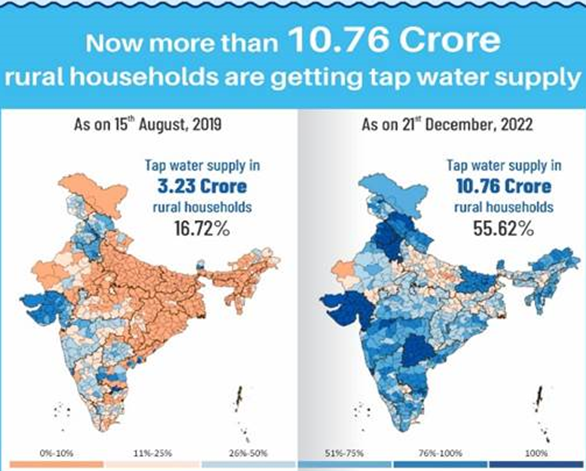
Coverage of Potable Tap Water to JE-AES Affected Districts:
- The GOI accords priority toJapanese Encephalitis (JE)-Acute Encephalitis Syndrome (AES) affected Districts to ensure potable tap water supply in all the households under Jal Jeevan Mission.
Status of Water Quality Monitoring and Surveillance:
- In 2022-23, as of date, more than 27 lakh water samples have been tested in laboratories.
National WASH Expert:
- National Centre for Drinking Water, Sanitation, and Qualityhas been entrusted with the task of empanelment and deployment of National WASH Experts for ground truthing and technical assistance to States in the implementation of the Jal Jeevan Mission (JJM).
- During 2022, 62 teams have visited around 1,035 villages for ground truthing of the implementation work done under JJM.
Reduction of Water Borne Diseases
- As per the report from National Centre for Disease Control (NCDC), with the availability of safe and potable drinking water at the doorstep of every rural household, the water-borne disease has been drastically reduced.
|
Year |
Water-borne Diseases |
|
2019 |
177 Lakhs |
|
2020 |
89 Lakhs |
|
2021 |
59 Lakhs |
Use of Technologies for Drinking Water Supply and Water Quality
- JJM focuses on various technologies for the community-led implementation of:
- Source sustainability measuressuch as aquifer recharge, rainwater harvesting, the increased storage capacity of water bodies, reservoirs, desilting, etc. to improve the lifespan of water supply systems.
- Technologies like the Internet of Things (IoT)for Supervisory Control and Data Acquisition (SCADA), remote sensing, and design software have been used in building climate resilience through water accounting, water quality control, water use efficiency, water resource planning, and impact assessment.
Grievance Redressal Mechanism:
- A grievance Redressal Cell has been constituted in the Department to address the grievances related to the water supply. People are lodging their complaints through the Centralized Public grievances Redress and Monitoring System (CPGRAMS).
Launch of Jeevan Survekshan (JJS) Toolkit:
- ‘Jal Jeevan Survekshan’ toolkit and dashboard were launched in 2021 with the aim to incentivize States/ Districts functionaries to strive for better performances and improved water service delivery in rural areas.
Key Achievements of SBM-G
Coverage:
- 25 lakhs villages declared Open Defecation Free (ODF)Plus in 2022.
- To prioritize Liquid Waste Management“Sujlam” campaign was launched.
- Under the“GOBARdhan” initiative of SBM(G), 96 community/cluster-level Biogas Plants have been established since January 2022.
Retrofit to Twin Pit Abhiyan:
- Launched by Union Minister of Jal Shakti in 2022 for safe disposal of faecal sludge through a simple on-site methodology of retrofitting single pit toilets to twin pit toilets.
Launch of Swachh Survekshan Grameen 2023 (SSG 2023):
- Launched to create healthy competition amongst States, Districts and Gram Panchayatsand to ascertain the progress of SBM-G Phase II.
- Under SSG 2023, the assessment will be undertaken at Gram Panchayat and District level.
Content Source Link:
https://pib.gov.in/PressReleasePage.aspx?PRID=1886953#:~:text=India%20has%20resolved%20to%20make,prescribed%20quality%20on%20regular%20basis
Online Safety & G20 Digital Innovation: G20 Presidency
In news
- Recently, as part of India's G20 presidency, the Minister for Electronics & Information Technology, Communications and Railways has launched the "Stay Safe Online" campaign and the “G20 Digital Innovation Alliance” (G20-DIA).
About Stay Safe Online Campaign
- The objective of the ‘Stay Safe Online Campaign’ is to raise awareness among citizens to stay safe in the online world due to the widespread use of social media platforms and the rapid adoption of digital payments.
About G20 Digital Innovation Alliance
- The objective is to identify, recognize, and enable the adoption of innovative and impactful digital technologies developed by startups, from G20 nations as well as the invited non-member nations, which can address the needs of humanity in the critically important sectors of Agri-tech, Health-tech, Ed-tech, Fin-tech, Secured Digital Infrastructure, and Circular Economy.
Content Source Link:
https://www.pib.gov.in/PressReleasePage.aspx?PRID=1887114
Current Account Deficit - Edukemy Current Affairs
- Context: India’s current account deficit widened to 4.4% in Q2 FY2023.
- The CAD is a measurement of a country’s trade where the value of the goods and services imported exceeds the value of the products exported.
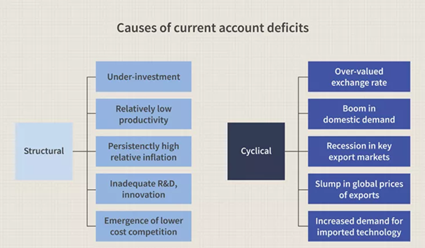
- The current account includes net income, such as interest and dividends, and transfers, such as foreign aid.
- The current account represents a country’s foreign transactions and, like the capital account, is a component of a country’s balance of payments (BOP).
- A country can reduce its existing debt by increasing the value of its exports relative to the value of imports. A country can opt for:
-
- Restrictions on imports, such as tariffs or quotas
- Export promotion policies, such as import substitution, industrialization, or policies that improve domestic companies' global competitiveness
- Monetary policy to improve the domestic currency’s valuation relative to other currencies through devaluation, which reduces the country’s export costs.
- Having a current account deficit is not inherently disadvantageous. If a country uses external debt to finance investments that have higher returns than the interest rate on the debt, the country can remain solvent while running a current account deficit.
Source:
https://indianexpress.com/article/business/economy/cad-widens-to-usd-36-4-bn-or-4-4-pc-of-gdp-in-q2-rbi-data-8351098/lite/
https://www.investopedia.com/terms/c/currentaccountdeficit.asp
Bonda Tribes - Edukemy Current Affairs
- Context: A growing number of people are seeking localised and personalised travel experiences around Araku valley, home to the Bonda tribe.

- The Bonda Tribe are one of the most primitive and backward tribes, living in isolation in remote and inaccessible areas.
- They have been given Particularly Vulnerable Tribal Group Status.
- Occupation: These tribals are engaged in collection of major forest produce such as Bauhenia leaves, Tamarind, tree bark, Honey and Gum and the same are disposed in the weekly shandies (market places) in exchange for domestic requirements.
- Location: adjoining areas on the border of Andhra Pradesh, Chhattisgarh and Orissa
- Location based division:
-
- Upper Bonda: living in inaccessible forested hills
- Lower Bonda: living in plains
- Cultural background:
-
- Munda lineage
- Mundari language
- Matriarchal society
- Women carry ornaments
- Men carry weapons such as bow and arrows
|
The government of India follows the following criteria for the identification of PVTGs. 1. Pre-agricultural level of technology 2. Low level of literacy 3. Economic backwardness 4. A declining or stagnant population. |
Source:
https://www.thehindu.com/life-and-style/travel/experiential-travel-on-the-rise-in-visakhapatnam/article66316363.ece/amp/
https://pib.gov.in/newsite/erelcontent.aspx?relid=64247
Remote EVM - Edukemy Current Affairs
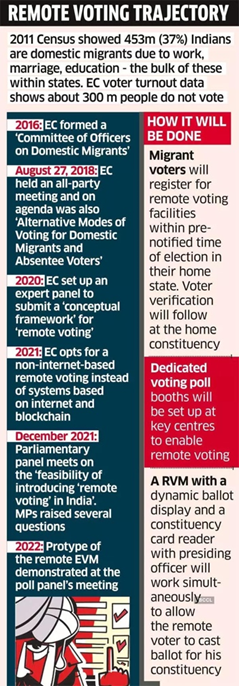
- Context: The Election Commission of India has said that it has developed a prototype for a Multi-Constituency Remote Electronic Voting Machine which would enable remote voting by migrant voters.
- The proposed RVM system would enable domestic migrants to participate in elections in their home constituencies, from their remote locations, i.e. the places of their work.
- A remote voter will have to pre-register for the remote voting facility by applying online or offline within a pre-notified time before elections.
- Voter details will be verified at the home constituency and the voter's request for remote voting will be approved after successful verification.
- Special multi-constituency remote voting polling stations will be set up in the places of their current residence.
- A remote voting machine is a standalone, non-networked system having the same security features as the existing EVMs. It provides the same voting experience to the voter as EVM. The RVM system is essentially a modified version of the existing EVM system.
Source:
https://www.hindustantimes.com/india-news/election-commission-develops-evm-prototype-for-migrants-oppn-raises-concerns-101672340680819.html
Ahilyabhai Holkar - Edukemy Current Affairs
- Context: Maharashtra Education Minister has sought a proposal to rename the Western Maharashtra city of Ahmednagaras ‘Punyashlok Ahilyadevi Nagar’.
|
The Holkars
|
- Ahilyabai Holkar (1725-1795) was the ruler and Queen of the Kingdom of Malwa.
- Popularly known as Rajmata Ahilyadevi Holkar, she was married into the esteemed Maratha community of the Holkars.
- After her husband’s martyrdom in the battle of Kumbher in 1754, she was exposed to the administrative and military affairs of the state and became ruler of Malwa.
- Ahilyadevi, a brave warrior and skilled archer, protected her kingdom from the plunder of Bhils and Gonds.
- She moved her capital to Maheshwar, constructing Ahilya Fort, on the banks of the sacred Narmada River.
- Achievements:
-
- Transforming Indore from an erstwhile village into a prosperous city
- Renovating temples
- Construction of numerous temples (Kashi Vishwanath temple) and pilgrimage (Gaya, Somnath, Ayodhya, Mathura, Hardwar, Dwarka, Badrinarayan, Rameshwar and Jaganathpuri).
- She passed away in 1795.
- The Government issued a commemorative stamp in her memory and the citizens of Indore have instituted an annual award in her name to an outstanding public figure (first recipient was Nanaji Deshmukh).
Source:
https://indianexpress.com/article/explained/explained-culture/maharashtra-proposes-renaming-ahmednagar-ahilyabai-holkar-8350423/#:~:text=Maharashtra%20Education%20Minister%20Deepak%20Kesarkar,century%20Malwa%20queen%2C%20Ahilyabai%20Holkar.
Image source:
https://twitter.com/newsflicks/status/865771607037534209
Ethylene Glycol - Edukemy Current Affairs
Why in news? Recently, India has sought a casualty status report after Uzbekistan claimed that at least 18 children died after consuming India-made medicinal syrup.
About:

- It is also known as Ethane-1,2-diol or Monoethylene glycol.
- It has no smell and is viscous. It is colourless and has a sweet taste.
- It is often found as a contaminant in glycerin, which is used as a sweetener in the manufacture of pharmaceutical cough syrups.
- It is also used in industrial products such as paints, stationery inks, fluids used in brakes and clutches of vehicles, and antifreeze.
- It causes toxic effects on humans.
- It can cause headaches, stomach pain, vomiting, diarrhoea, inability to pass urine, and serious kidney problems etc.
- Ethylene Glycol is produced when ethylene oxide reacts with water.
https://www.firstpost.com/explainers/explained-what-is-ethylene-glycol-toxic-substance-in-cough-syrups-linked-to-childrens-deaths-in-uzbekistan-11894551.html/amp
Project Nilgiri Tahr - Edukemy Current Affairs
Why in news? Tamil Nadu is set to implement Project Nilgiri Tahr, to protect the state animal.
About:

- The Nilgiri tahr is endemic to the Nilgiri Hills and the southern portion of the Western and Eastern Ghats in the states of Tamil Nadu and Kerala in southern India.
- Project Nilgiri Tahr:
- Announced during the Tamil Nādu state budget 2022-23.
- The project will be implemented over the span of five years- 2022-27.
- The project will have nine components, including bi-annual synchronised surveys across the division, diagnosis and treatment for affected individuals and the Shola grassland restoration pilot in Upper Bhavan.
- It aims to restore the fragmented habitat, especially Shola grasslands where it thrives, reintroduce the Tahr population in its historic habitat and ensure proper rehabilitation facilities are provided.
https://m.timesofindia.com/city/chennai/project-to-protect-nilgiri-tahr-tamil-nadu-animal-launched/amp_articleshow/96588874.cms
V-shaped recovery - Edukemy Current Affairs
Why in news? India’s civil aviation sector is witnessing a very strong V-shaped recovery with encouraging domestic passenger numbers.
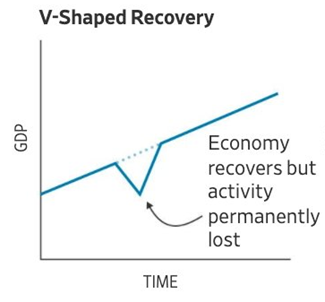 About:
About:
- A V-shaped recovery is characterized by a quick and effective recovery in measures of economic performance after an acute decline in the economy.
- Such recoveries are generally spurred by rapid readjustment of consumer demand and business investment spending.
- The recoveries that followed the recessions of 1920-21 and 1953 in the U.S. are examples of V-shaped recoveries.
https://www.thehindu.com/business/civil-aviation-sector-witnessing-strong-v-shaped-recovery-domestic-passenger-growth-will-continue-scindia/article66314105.ece/amp/
Delegated legislation - Edukemy Current Affairs
Why in news? Rules made by the Centre, State cannot exceed powers granted by parent statute, Supreme Court has held in a judgment.
About:
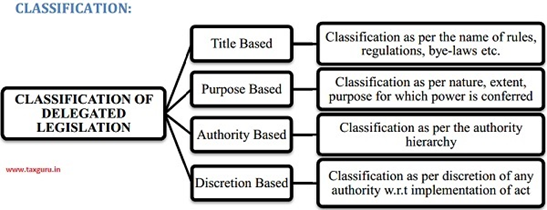
- ‘Delegated legislation’ means exercising of legislative power by an agent who is lower in rank to the Legislature, or who is subordinate to the Legislature.
- This type of legislation is also known as secondary legislation.
- It refers to those laws made by persons or bodies to whom parliament has delegated or given law-making authority.
- There are three forms of delegated legislation i.e., statutory instrument, orders in council and by-laws.
https://www.thehindu.com/news/national/rules-made-by-centre-state-cannot-exceed-powers-granted-by-parent-statute-sc/article66313557.ece/amp/
Blizzard - Edukemy Current Affairs
Why in news? Recently, Across the US, at least 62 people have died in weather-related incidents.
About:
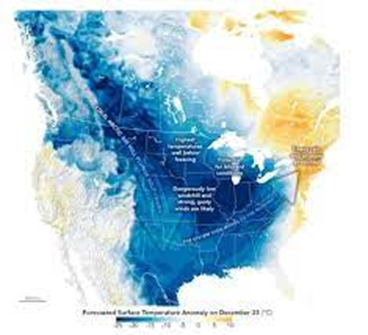
- The air flows from high to low pressure, creating winds. Storms form when a mass of low-pressure air meets a high-pressure mass.
- A blizzard is a severe snowstorm characterised by low visibility and strong sustained winds lasting for a very long period of time usually around three or four hours.
- The size of blizzards is so massive that it spreads over a distance of hundreds of kilometres or even thousands of kilometres.
- Blizzards are at higher altitudes.
- Occur only in winter.
https://www.bbc.com/news/world-us-canada-64099642.amp
Ram Setu - Edukemy Current Affairs
Why in news? A prolonged litigation initiated by a former Rajya Sabha member to declare the Ram Setu a national heritage monument lies pending in the Supreme Court.
About:
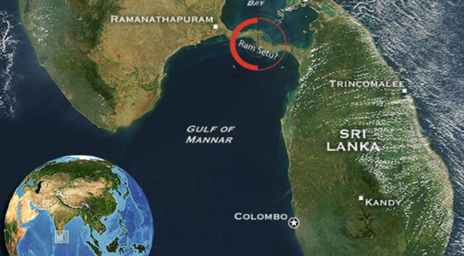
- It is also known as Adam’s Bridge.
- It is a 48-km chain of limestone shoals between Rameswaram on India’s southeast coast and Mannar Island near Sri Lanka’s northwest coast.
- The structure has significance in both Hindu and Muslim mythology
- While Hindus believe this is the bridge (setu) built by Lord Ram and his army to cross to Lanka and fight Ravan.
- As per Islamic legend, Adam used this bridge to reach Adam’s Peak in Sri Lanka, where he stood on one foot for 1,000 years in repentance.
- Scientists believe Ram Setu is a natural structure formed due to tectonic movements and sand getting trapped in corals.
https://www.thehindu.com/news/national/centre-yet-to-make-its-stand-clear-on-ram-setu-petition/article66310973.ece/amp/
A retelling of the Indian migrant worker’s plight: The Hindu
Exam View: International Organization of Migration (IOM), UN State of the World Population report, Covid-19 pandemic, International Labour Organization (ILO), Unorganised workers, National Food Security Act List. Positive Effects of Domestic Migration in India, Challenges Associated with Domestic Migration in India, Sustainable Development Goals and Migrants.
In News:
According to the International Organization of Migration (IOM)’s World Migration Report 2022, there were 281 million international migrants globally in 2020, with nearly two-thirds being labour migrants.
Population pressure on cities has increased with the development of the manufacturing and service sectors. According to the “World Cities Report 2022, India's urban population to stand at 675 million by 2035. A result of urbanisation and the growth of cities in India is a significant strain on basic infrastructure and services, particularly housing and sanitation. Migrant workers suffer most from the lack of access to these basic needs.
The Covid-19 pandemic has further aggravated the poor housing conditions of the urban poor/ migrant workers. So, it's high time India started addressing the issues facing migrants in a comprehensive manner and worked towards improving their living conditions.
Positive Effects of Domestic Migration in India
- Diversifying Labour Markets:Migration fills the gap between demand and supply for labour and efficiently allocates skilled, unskilled, and cheap labour.
- Development of Skills:Exposure and interaction with the outside world enhance migrants' knowledge and skills.
- Quality of Life:Migration enhances employment opportunities and economic prosperity, which in turn improves the quality of life. The migrants also send money home, which has a positive effect on their families back to their hometown.
- Social Evolution:Migration helps to improve the social life of migrants, as they learn about new cultures, customs, and languages which helps to improve brotherhood among people and ensures greater equality and tolerance.
- Food and Nutrition Security:According to the 2018 State of Food and Agriculture report by the Food and Agriculture Organisation (FAO), outmigration often leads to improved food and nutrition security for migrants.

|
Sustainable Development Goals Recognise Migrants |
|
Challenges Associated with Domestic Migration in India
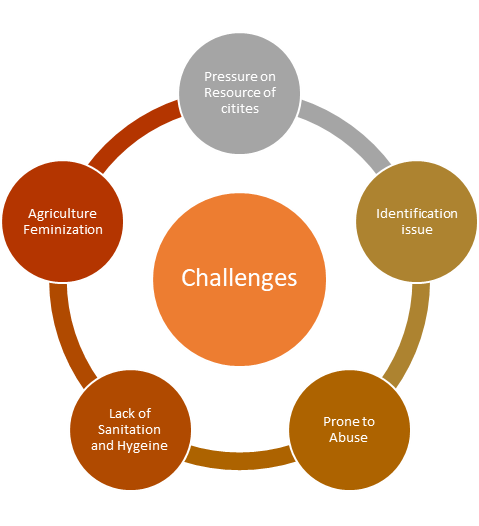
- Agriculture Feminisation: Due to theireducational opportunities and preference for physical labour, men are typically viewed as breadwinners. Due to this, males in the Indian rural belt tend to migrate to urban areas in search of better jobs, whereas women are primarily responsible for household chores and agriculture.
- Lack of Sanitation and Hygiene:In a 2020 report by the International Labour Organization (ILO) on internal migrants, the lack of adequate water, sanitation, and hygiene (WASH) facilities have been a major challenge for migrant workers.
- Identification issue:Migrants are placed within two larger categories that have troubled policymakers for a long time: unorganised workers and urban poor. Despite the use of the e-Shram portal, it has been difficult to accurately distinguish and target migrants.
- Pressure on Resources of Host Cities: The influx of workers and population explosion increase competition for jobs, houses, schools,etc, and overpopulation overloads resources, amenities, and services in host cities and compromises the quality of infrastructure and life at destinations, which further causes unhygienic conditions, crime, and pollution.
- Prone to Abuse: Non-literate and underqualified migrants lack basic knowledge and remain out of the pursuit of formal jobswhich makes them prone to abuse, exploitation, trafficking, psychological abuse, and gender-based violence against female migrants.
Way Forward
- Changes in migration Policies:In order to achieve inclusive growth and development and reduce distress-induced migration, India needs to develop migration-centric policies, strategies, and institutional mechanisms, helping India on the path of achieving Sustainable Development Goals and reducing poverty.
- Social Security: Having asocial security blanket is important to ensure migrants do not run out of funds during health crises, child-rearing, or child education. As a result, migrants' psychological conditions will also improve.
- Upgradation of Slums areas:Providing basic amenities such as Clean Water, Sanitation and Electricity to the slum areas should be a priority. Slums need to be rehabilitated and upgraded along with establishing identity markers based on the National Food Security Act List as well as recording the hygiene condition.
- Urban Employment Guarantee:To provide basic living standards to the urban poor as well as migrants, urban areas need a scheme similar to The Indira Gandhi Urban Employment Guarantee Scheme has been rolled out in Rajasthan and is a good step in this direction.
- Focus on Informal Economy:Migrant data must be collected for the purpose of city development like the SMART Cities Mission can result in a large number of green jobs for migrants. The Labour Ministry's proposed Unorganised Worker Index Number Card would also help formalise the workforce.
https://www.thehindu.com/opinion/op-ed/a-retelling-of-the-indian-migrant-workers-plight/article66311091.ece
Landslide: Joshimath battles a sinking feeling
Background
The spiritual getaway in the Himalayas, Joshimath is facing increased subsidence over the past two years, leading to cracks in houses and lands. This has made the area inhabitable causing people to relocate out of Joshimath.
In 1976, Mishra Commission was mandated to find the cause of landslide and sinking, which had warned of the high vulnerability of Joshimath to land subsidence.
What are the reasons for subsidence?
- High geological sensitivity of the region, categorically to land subsidence and landslide.
- Haphazard construction on fragile mountain terrains that have loose rock,
- Seepage of water subsurface, erosion of topsoil, and periodic seismic activities coupled with the absence of the assessment of the carrying capacity of the ground.
- Construction of a hydropower tunnel below the town using heavy machinery led to the puncturing of the aquifer in 2009-10 and led to destabilizing of the fragile rocks
- Large boulders of gneisses and fragments of basic and schistose rocks are embedded in the area, contributing significantly to the gradual sinking of the area.
- Expansion of channels or changing of courses of rivers as shown by satellite data has induced greater slope instability.
- Merciless destruction of natural forest cover in the Joshimath area
What are the recommendations to arrest the subsidence?
- Prohibition to haphazard construction and the use of heavy machinery for rock cutting.
- Pavement and roads to be properly compacted and consolidated;
- Seepage from drains carrying stormwater as also household wastewater is to be minimized through routine maintenance and repairs; and the planning and lining of the town’s drainage system.
- Afforestation drive to prevent soil erosion and hold soil compactly.
Source:
https://www.hindustantimes.com/india-news/spiritual-town-joshimath-battles-a-sinking-feeling-101672250419893-amp.html
Share the article
Get Latest Updates on Offers, Event dates, and free Mentorship sessions.

Get in touch with our Expert Academic Counsellors 👋
FAQs
UPSC Daily Current Affairs focuses on learning current events on a daily basis. An aspirant needs to study regular and updated information about current events, news, and relevant topics that are important for UPSC aspirants. It covers national and international affairs, government policies, socio-economic issues, science and technology advancements, and more.
UPSC Daily Current Affairs provides aspirants with a concise and comprehensive overview of the latest happenings and developments across various fields. It helps aspirants stay updated with current affairs and provides them with valuable insights and analysis, which are essential for answering questions in the UPSC examinations. It enhances their knowledge, analytical skills, and ability to connect current affairs with the UPSC syllabus.
UPSC Daily Current Affairs covers a wide range of topics, including politics, economics, science and technology, environment, social issues, governance, international relations, and more. It offers news summaries, in-depth analyses, editorials, opinion pieces, and relevant study materials. It also provides practice questions and quizzes to help aspirants test their understanding of current affairs.
Edukemy's UPSC Daily Current Affairs can be accessed through:
- UPSC Daily Current Affairs can be accessed through Current Affairs tab at the top of the Main Page of Edukemy.
- Edukemy Mobile app: The Daily Current Affairs can also be access through Edukemy Mobile App.
- Social media: Follow Edukemy’s official social media accounts or pages that provide UPSC Daily Current Affairs updates, including Facebook, Twitter, or Telegram channels.



